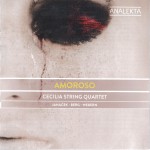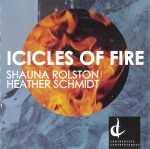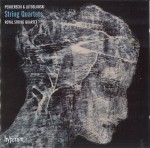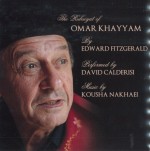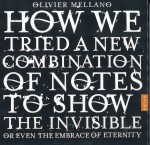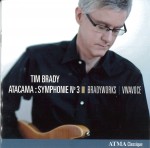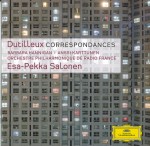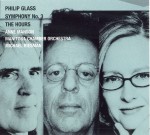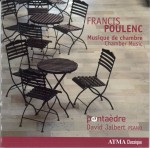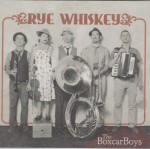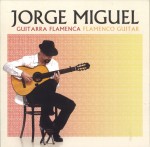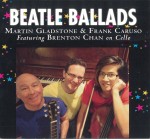EDITOR’S CORNER
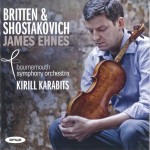 I will begin with apologies to Terry Robbins. Due to his personal itinerary this month several discs arrived too late to be included in his Strings Attached column which, I must admit, I am happy to be able to add to my own collection. First is the latest release from Canadian superstar James Ehnes – Britten & Shostakovich Violin Concertos (Onyx 4113) performed with the Bournemouth Symphony Orchestra under the direction of Kirill Karabits. Following on his 2013 Juno Award-winning Tchaikovsky recording with the Sydney Symphony and Vladimir Ashkenazy (Onyx 4076), Ehnes’ performances are everything that we’ve come to expect. But what really caught me about this recording is the pairing of the Britten with Shostakovich’s First. These two works, written ten years apart, bear remarkable similarities and as presented here the opening Nocturne of the Shostakovich seems to grow inherently out of the slow Passacaglia finale of the Britten. I’m surprised that these works are not more often presented together. As a matter of fact this seems to be the only recording currently available which includes them both. Malcolm MacDonald’s booklet notes are thorough and enlightening. The orchestral sound is irreproachable and as mentioned above, Ehnes is in top form.
I will begin with apologies to Terry Robbins. Due to his personal itinerary this month several discs arrived too late to be included in his Strings Attached column which, I must admit, I am happy to be able to add to my own collection. First is the latest release from Canadian superstar James Ehnes – Britten & Shostakovich Violin Concertos (Onyx 4113) performed with the Bournemouth Symphony Orchestra under the direction of Kirill Karabits. Following on his 2013 Juno Award-winning Tchaikovsky recording with the Sydney Symphony and Vladimir Ashkenazy (Onyx 4076), Ehnes’ performances are everything that we’ve come to expect. But what really caught me about this recording is the pairing of the Britten with Shostakovich’s First. These two works, written ten years apart, bear remarkable similarities and as presented here the opening Nocturne of the Shostakovich seems to grow inherently out of the slow Passacaglia finale of the Britten. I’m surprised that these works are not more often presented together. As a matter of fact this seems to be the only recording currently available which includes them both. Malcolm MacDonald’s booklet notes are thorough and enlightening. The orchestral sound is irreproachable and as mentioned above, Ehnes is in top form.
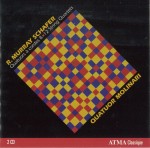 Quatuor Molinari’s latest ATMA release (ACD2 2672) completes their cycle of the 12 (currently existing) String Quartets of R. Murray Schafer. Following their 2000 release of the first seven quartets and in 2003 the eighth quartet paired with Theseus and Beauty and the Beast, the current double CD includes new recordings of Quartets 9 to 12 and a re-issue of No.8. Since the recording of the first set the personnel of the quartet has changed substantially, with only founding first violinist Olga Ranzenhofer remaining. The current line-up includes Frédéric Bednorz, Frédéric Lambert and Pierre-Alain Bouvrette. They seem as comfortable and confident in this sometimes challenging, and oft’ times playful, repertoire as their forerunners. I would be curious though to know whether Bouvrette will prove as adept at playing the cello while marching as his predecessor Julie Trudeau was in the Seventh Quartet when the Molinari performed a Schafer marathon at Glenn Gould Studio back in 2003.
Quatuor Molinari’s latest ATMA release (ACD2 2672) completes their cycle of the 12 (currently existing) String Quartets of R. Murray Schafer. Following their 2000 release of the first seven quartets and in 2003 the eighth quartet paired with Theseus and Beauty and the Beast, the current double CD includes new recordings of Quartets 9 to 12 and a re-issue of No.8. Since the recording of the first set the personnel of the quartet has changed substantially, with only founding first violinist Olga Ranzenhofer remaining. The current line-up includes Frédéric Bednorz, Frédéric Lambert and Pierre-Alain Bouvrette. They seem as comfortable and confident in this sometimes challenging, and oft’ times playful, repertoire as their forerunners. I would be curious though to know whether Bouvrette will prove as adept at playing the cello while marching as his predecessor Julie Trudeau was in the Seventh Quartet when the Molinari performed a Schafer marathon at Glenn Gould Studio back in 2003.
When the Orford Quartet recorded the first cycle of Schafer string quartets, then numbering five, for the Centrediscs label in 1990, producer David Jaeger suggested that the individual works could be considered movements of one large piece, much the same way that Schafer’s Patria series of music theatre works constitute a whole. There are many internal references from one quartet to the next and this has continued throughout the extended cycle.
Due in part to timing considerations within the medium of the compact disc I expect, the current set begins with the Ninth Quartet and continues chronologically through the Twelfth with the 2003 recording of the Eighth added as an appendix at the end of the second disc. This serves the double purpose of isolating the previously released material but also, since the Ninth begins by quoting a theme from the Eighth, of bringing the mini-cycle full circle to where the first disc began. Including the re-issue in this new set also facilitates listening for those who want to experience all 12 quartets by including the first seven on one set (ACD2 2188/89) and the remaining five on this new collection. Kudos to the Molinari, past and present, for their documentation of and dedication to this outstanding and unique cycle from one of Canada’s foremost composers. One of my summer projects will be to take up the challenge and listen to all 12 as one über quartet.
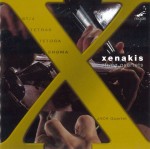 Our WholeNote reviews tend to focus on the best of the plethora of new releases we receive each month, but there are sometimes reasons for visiting or re-visiting older discs. One example of this is Jack MacQuarrie’s review of a 2005 CD by flutist Christopher Lee later in these pages. It is a disc we missed when it was released and which came to MacQuarrie’s attention at a recent live performance. Since Lee is a very active part of the Canadian Flute Convention in Oakville at the end of June it was decided to include a review in the current issue. Similarly, I had the exceptional experience of hearing the Complete String Quartets of Iannis Xenakis performed by the JACK Quartet during the recent Random Walks – Music of Xenakis and Beyond festival/symposium presented by the Fields Institute at the University of Toronto and the Perimeter Institute in Waterloo. This music is definitely not for the faint of heart, with its density and abrasiveness, but when heard in the context of explanatory papers at the symposium and so stunningly performed by a group that has truly made these works their own, it was exhilarating. The program notes by James Harley were reprinted from the 2009 Xenakis Edition Volume 10 (Mode 209) compact disc and during a break I went in search of it. After checking Grigorian (they had several volumes of the series, but not the quartets) and HMV with no luck, I remembered that someone had mentioned an independent shop with quite an eclectic collection. I’d like to thank whoever that was, and Soundscapes (572 College St.) where the disc was indeed in stock. This was JACK’s first appearance in Toronto (although it turns out that three of the members, all but the current violist, did come here for a masterclass with Helmut Lachenmann presented by New Music Concerts back in 2003) and they certainly lived up to their reputation as one of the foremost contemporary ensembles in the world. I await their return with bated breath and in the interim will revisit their recording time and time again.
Our WholeNote reviews tend to focus on the best of the plethora of new releases we receive each month, but there are sometimes reasons for visiting or re-visiting older discs. One example of this is Jack MacQuarrie’s review of a 2005 CD by flutist Christopher Lee later in these pages. It is a disc we missed when it was released and which came to MacQuarrie’s attention at a recent live performance. Since Lee is a very active part of the Canadian Flute Convention in Oakville at the end of June it was decided to include a review in the current issue. Similarly, I had the exceptional experience of hearing the Complete String Quartets of Iannis Xenakis performed by the JACK Quartet during the recent Random Walks – Music of Xenakis and Beyond festival/symposium presented by the Fields Institute at the University of Toronto and the Perimeter Institute in Waterloo. This music is definitely not for the faint of heart, with its density and abrasiveness, but when heard in the context of explanatory papers at the symposium and so stunningly performed by a group that has truly made these works their own, it was exhilarating. The program notes by James Harley were reprinted from the 2009 Xenakis Edition Volume 10 (Mode 209) compact disc and during a break I went in search of it. After checking Grigorian (they had several volumes of the series, but not the quartets) and HMV with no luck, I remembered that someone had mentioned an independent shop with quite an eclectic collection. I’d like to thank whoever that was, and Soundscapes (572 College St.) where the disc was indeed in stock. This was JACK’s first appearance in Toronto (although it turns out that three of the members, all but the current violist, did come here for a masterclass with Helmut Lachenmann presented by New Music Concerts back in 2003) and they certainly lived up to their reputation as one of the foremost contemporary ensembles in the world. I await their return with bated breath and in the interim will revisit their recording time and time again.
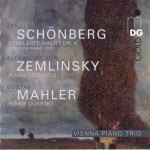 I will thank Bruce Surtees for my next foray into the archives. In his review of a new recording of Schoenberg’s Verklärte Nacht by the Emerson String Quartet and friends, Bruce mentioned that Eduard Steuermann, a student of Schoenberg, had made a transcription of the fabled work for piano trio. This whetted my appetite as an amateur cellist who loves to play trios, quartets and quintets with friends, and I was very pleased to find several choices of recording available at Atelier Grigorian (70 Yorkville Ave.). I chose the 2005 Vienna Piano Trio version (Dabringhaus und Grimm MDG 342 1354-2) because I found the inclusion of Zemlinsky’s Piano Trio and Mahler’s piano quartet movement to be most appropriate. I am happy to say that I found Steuermann’s adaptation for violin, cello and piano of Schoenberg’s string sextet very satisfying, in fact more so than I might have expected. Steuermann was a renowned pianist and his arrangement captures the density of the score without sacrificing any of the subtlety. The performance is convincing and the sound quality on the mdg “gold” disc is clear and robust. I’ve added having a hands-on go at this arrangement as another one of my summer aspirations.
I will thank Bruce Surtees for my next foray into the archives. In his review of a new recording of Schoenberg’s Verklärte Nacht by the Emerson String Quartet and friends, Bruce mentioned that Eduard Steuermann, a student of Schoenberg, had made a transcription of the fabled work for piano trio. This whetted my appetite as an amateur cellist who loves to play trios, quartets and quintets with friends, and I was very pleased to find several choices of recording available at Atelier Grigorian (70 Yorkville Ave.). I chose the 2005 Vienna Piano Trio version (Dabringhaus und Grimm MDG 342 1354-2) because I found the inclusion of Zemlinsky’s Piano Trio and Mahler’s piano quartet movement to be most appropriate. I am happy to say that I found Steuermann’s adaptation for violin, cello and piano of Schoenberg’s string sextet very satisfying, in fact more so than I might have expected. Steuermann was a renowned pianist and his arrangement captures the density of the score without sacrificing any of the subtlety. The performance is convincing and the sound quality on the mdg “gold” disc is clear and robust. I’ve added having a hands-on go at this arrangement as another one of my summer aspirations.
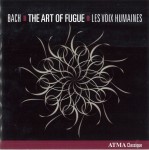 In brief, a few more summer projects: Another lovely new disc that arrived too late for full review treatment is a breathtaking performance of Bach’s The Art of the Fugue by Les Voix humaines Consort of Viols (ATMA ACD2 2645). Core members of Les Voix humaines Margaret Little, pardessus or high voiced viol, and Susie Napper, bass viol, are joined by Melisande Corriveau, treble and alto viols, and Felix Deak, tenor viol, in this period performance. I look forward to revisiting other realizations of this incredible unfinished work by the master of counterpoint in the coming months. My collection includes a modern instrument treatment by the Juilliard String Quartet, a mixed strings and winds version featuring the Fine Arts Quartet and the New York Woodwind Quintet which was my first exposure to this masterpiece some four decades ago, Glenn Gould’s (incomplete and only) organ recording and a version by the Alexander and Daykin Piano Duo. Let me say for now that I think Les Voix humaines will prove to be a tough act to follow.
In brief, a few more summer projects: Another lovely new disc that arrived too late for full review treatment is a breathtaking performance of Bach’s The Art of the Fugue by Les Voix humaines Consort of Viols (ATMA ACD2 2645). Core members of Les Voix humaines Margaret Little, pardessus or high voiced viol, and Susie Napper, bass viol, are joined by Melisande Corriveau, treble and alto viols, and Felix Deak, tenor viol, in this period performance. I look forward to revisiting other realizations of this incredible unfinished work by the master of counterpoint in the coming months. My collection includes a modern instrument treatment by the Juilliard String Quartet, a mixed strings and winds version featuring the Fine Arts Quartet and the New York Woodwind Quintet which was my first exposure to this masterpiece some four decades ago, Glenn Gould’s (incomplete and only) organ recording and a version by the Alexander and Daykin Piano Duo. Let me say for now that I think Les Voix humaines will prove to be a tough act to follow.
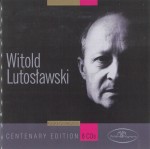 I have mentioned New Music Concerts in the preceding paragraphs and in the spirit of full disclosure I feel I must remind you that my “day job” is general manager of that illustrious institution, English Canada’s oldest new music society (is that an oxymoron?). That task has brought with it not only the privilege of working with Robert Aitken, one of the world’s finest musicians, but also the opportunity to meet some of the most renowned composers from around the globe, including Helmut Lachenmann mentioned above, and the late, great Witold Lutosławski. In April NMC celebrated the centenaries of six influential composers including Lutosławski. On that occasion we welcomed the collaboration of the Consulate of the Republic of Poland, which has declared 2013 the Year of Lutosławski. We were presented with the Witold Lutosławski Centenary Edition (Polskie Nagrania PNCD BOX 0009 A/H), an eight-CD set of historic recordings by Polish Radio, including a number of first performances, many with the conductor at the podium. Although not complete – some notable omissions are the Symphonic Variations, Les espaces du sommeil and the Sacher Variations for solo cello, one of very few chamber works by this master – the set includes almost ten hours of music and some gems like the first Polish performance of the seminal String Quartet featuring the LaSalle Quartet. It will take me most of the summer to work through this wealth of material, which may be complicated by the fact that Naxos is on the verge of releasing its own centenary set of collected Lutosławski recordings. This latter will include the last concert he ever conducted, featuring violinist Fujiko Imajishi and the New Music Concerts Ensemble at the Premiere Dance Theatre in Toronto on October 24, 1993. A summer’s worth of listening indeed!
I have mentioned New Music Concerts in the preceding paragraphs and in the spirit of full disclosure I feel I must remind you that my “day job” is general manager of that illustrious institution, English Canada’s oldest new music society (is that an oxymoron?). That task has brought with it not only the privilege of working with Robert Aitken, one of the world’s finest musicians, but also the opportunity to meet some of the most renowned composers from around the globe, including Helmut Lachenmann mentioned above, and the late, great Witold Lutosławski. In April NMC celebrated the centenaries of six influential composers including Lutosławski. On that occasion we welcomed the collaboration of the Consulate of the Republic of Poland, which has declared 2013 the Year of Lutosławski. We were presented with the Witold Lutosławski Centenary Edition (Polskie Nagrania PNCD BOX 0009 A/H), an eight-CD set of historic recordings by Polish Radio, including a number of first performances, many with the conductor at the podium. Although not complete – some notable omissions are the Symphonic Variations, Les espaces du sommeil and the Sacher Variations for solo cello, one of very few chamber works by this master – the set includes almost ten hours of music and some gems like the first Polish performance of the seminal String Quartet featuring the LaSalle Quartet. It will take me most of the summer to work through this wealth of material, which may be complicated by the fact that Naxos is on the verge of releasing its own centenary set of collected Lutosławski recordings. This latter will include the last concert he ever conducted, featuring violinist Fujiko Imajishi and the New Music Concerts Ensemble at the Premiere Dance Theatre in Toronto on October 24, 1993. A summer’s worth of listening indeed!
We welcome your feedback and invite submissions. CDs and comments should be sent to: The WholeNote, 503 – 720 Bathurst St. Toronto ON M5S 2R4. We also encourage you to visit our website thewholenote.com where you can find added features including direct links to performers, composers and record labels, “buy buttons” for on-line shopping and additional, expanded and archival reviews.
David Olds, DISCoveries Editor
discoveries@thewholenote.com


